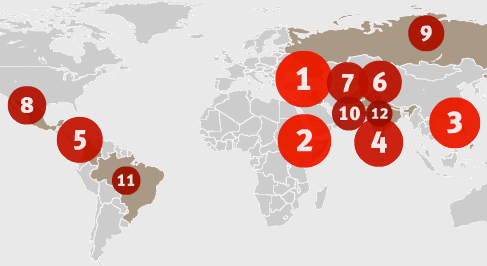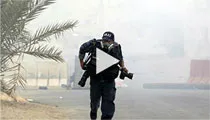As the military battled drug cartels–and the gangs clashed with one another–the press came under fire from criminals and corrupt officials seeking to control the flow of information. Journalists disappeared or were threatened or forced to flee in reprisal for their work, and several media outlets were attacked. Freelance journalist Adrían Silva Moreno was shot to death in Puebla shortly after the reporter had gathered information on a large-scale gasoline theft and then witnessed a stand-off between soldiers and gunmen. Five other journalists were murdered during the year; CPJ was investigating to determine whether the killings were work-related. After being repeatedly targeted, one daily published an editorial stating it would no longer report on cartel violence. In a sign of the public’s dissatisfaction with President Felipe Calderón Hinojosa’s bloody offensive against the cartels, the rival Institutional Revolutionary Party won back the presidency in an election that vaulted Enrique Peña Nieto to power. Calderón’s administration did have a landmark press freedom achievement in its final year. After years of advocacy by CPJ and other press freedom groups, Congress and the states passed a Calderón-backed constitutional amendment federalizing crimes against freedom of expression, a key step in combating local-level corruption and impunity. Still, the legislation needed to implement the amendment had yet to be passed in late year. At least 14 journalists were killed in retaliation for their work during Calderón’s presidency, which ran from December 2006 through December 2012, marking the tenure as one of the deadliest on record for the press anywhere in the world.
Mexico
» Several newsrooms targeted by bombs, gunfire as violent intimidation continues.
» Mexico adopts landmark measure that federalizes anti-press crimes.
As the military battled drug cartels–and the gangs clashed with one another–the press came under fire from criminals and corrupt officials seeking to control the flow of information. Journalists disappeared or were threatened or forced to flee in reprisal for their work, and several media outlets were attacked. Freelance journalist Adrían Silva Moreno was shot to death in Puebla shortly after the reporter had gathered information on a large-scale gasoline theft and then witnessed a stand-off between soldiers and gunmen. Five other journalists were murdered during the year; CPJ was investigating to determine whether the killings were work-related. After being repeatedly targeted, one daily published an editorial stating it would no longer report on cartel violence. In a sign of the public’s dissatisfaction with President Felipe Calderón Hinojosa’s bloody offensive against the cartels, the rival Institutional Revolutionary Party won back the presidency in an election that vaulted Enrique Peña Nieto to power. Calderón’s administration did have a landmark press freedom achievement in its final year. After years of advocacy by CPJ and other press freedom groups, Congress and the states passed a Calderón-backed constitutional amendment federalizing crimes against freedom of expression, a key step in combating local-level corruption and impunity. Still, the legislation needed to implement the amendment had yet to be passed in late year. At least 14 journalists were killed in retaliation for their work during Calderón’s presidency, which ran from December 2006 through December 2012, marking the tenure as one of the deadliest on record for the press anywhere in the world.
More journalists have gone missing in Mexico than in any other country in the world. At least nine were reported missing during President Calderón's six-year term, according to CPJ research. Crime photographer Miguel Morales Estrada was reported missing in Veracruz state in June 2012, according to news reports.

| Mexico: 12 Russia: 8 Democratic Republic of Congo: 2 Iraq: 2 Rwanda: 2 | Syria: 1 Sri Lanka: 1 Ukraine: 1 Kazakhstan: 1 Indonesia: 1 Ivory Coast: 1 | Egypt: 1 Serbia and Montenegro: 1 Algeria: 1 Lebanon: 1 |
An additional 27 journalists were murdered during the same period. CPJ is investigating whether those killings were work-related.
With at least 15 unsolved murders over the past decade, Mexico is the eighth worst nation in combating deadly anti-press violence, according to CPJ's Impunity Index, which spotlights countries where journalists are murdered regularly and killers go free.

| 1. Iraq 2. Somalia 3. Philippines 4. Sri Lanka | 5. Colombia 6. Nepal 7. Afghanistan 8. Mexico | 9. Russia 10. Pakistan 11. Brazil 12. India |
The offices of at least six media outlets were attacked in 2012, according to CPJ research. Three supplements of the Monterrey-based daily El Norte were attacked in July. The Nuevo Laredo-based daily El Mañana was targeted in the same month. In March, two outlets in the northeastern state of Tamaulipas were attacked within a week.
| 1 | Car Bomb |
| 2 | Grenade |
| 2 | Explosive Device |
| 1 | Gunfire |
| 1 | Arson |
* One office was simultaneously attacked by gunfire and a grenade.

